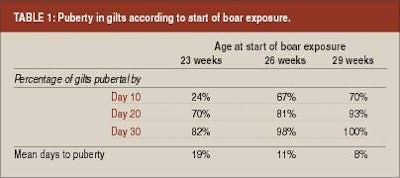
Gilt feeding and rearing practices came into the spotlight when the 10th Australasian Pig Science Association Conference was held in Christchurch, New Zealand the first time that the biennial meeting has taken place outside Australia. APSA's conferences are now established among the top events of their type worldwide. This time the meeting attracted an attendance of 320, mainly from the Southern Hemisphere and Asian countries although also with a good representation from North America and Europe. Attendees included a significant number of pig producers.
Among approximately 120 presentations on a variety of themes there was a paper by Dr Paul Hughes of the South Australia Research and Development Institute, who spoke about factors affecting puberty attainment and first litter size in replacement gilts. He recommended that current gilt management recommendations be modified so that they better suit modern, leaner genotypes. We should be looking more closely at boar exposure and the timing of the first mating, he declared.
Dr Hughes said that puberty is attained more rapidly and with greater synchrony within a group of gilts when boar exposure commences at 26-29 weeks of age, whereas starting exposure at 23 weeks results in a delayed and asynchronous response. In support of this conclusion, he offered the data from Australian trials summarised in Table 1.
He also proposed that delaying mating to the second or later oestrus may not be necessary provided that the gilt has sufficient fat reserves. A high feed intake before mating increases both the number and quality of eggs ovulated and the ability of fertilised ova to remain viable through the first 3 to 4 weeks of gestation, Dr Hughes pointed out. Immediately after ovulation, however, low-level feeding appears to increase the number of embryos that survive.
Still on the theme of managing gilts, R.J. Smits (University of Western Australia) described a case study where gilt rearing was changed from unbedded part-slatted pens to deep litter eco-sheds. Gilts in the new system were heavier at 27 weeks of age, with more backfat. Onset of oestrus was improved and wastage of gilts reduced. Better figures for sow retention and total piglet production, assessed over 2 parities, showed that the breeding performance of genetically lean gilts could be improved by manipulating their body reserves at boar exposure.
Sow longevity entered the picture again in remarks by Dr Don Levis of the University of NebraskaLincoln, USA. Pork producers are losing income from culling sows too soon, he asserted. Dr Levis described the use of a computer programme to calculate the number of parities a sow must reach to cover the costs incurred in bringing her to the breeding stage and produce a profit. Depending on the cost of the gilt, its litter size, number of litters per year and pig price, it is possible for one animal to show a net return after parity 2 while another might need to stay in the herd for 4 parities before showing a net return. Collecting more records does not solve the problem of high replacement rates, Dr Levis added, unless the cause of the excessive turnover is tackled as well as identified. His take-home message was to keep sows producing at a high level for as long as possible.
Welfare of the pregnant sow
Other reviews ranged over issues of animal welfare. With the welfare-led move to group housing of pregnant sows, for example, has there been a positive or negative effect on sow performance compared with the use of single stalls (crates) for the gestation period? American reviewer Dr R.S. Morrison (University of Minnesota) suggested from US studies that housing in groups could deliver a level of performance equal to the results achieved in individual penning. But, he warned, there are still many unanswered questions.
Australian presenter G.A. Karlen (University of Melbourne) suggested that sows in groups were more stressed than those kept in stalls in early pregnancy, but less stressed in late pregnancy. Optimal stall dimensions for pregnant sows were studied by Victoria, Australia, Department of Primary Industries scientists Dr Greg Cronin and Dr John Barnett. They concluded that 0.60m was better than 0.75m for the width of the gestation stall and that a length of 2.2m was better than 2.7m.
On a separate matter of no less importance internationally, the impact of air quality on animal health was discussed by Trish Holyoake of the University of Sydney, Australia. She explained how high levels of aerial contaminants (dust, gases, bacteria, fungi) have clearly deleterious effects on the health and the performance of pigs. Also, she pointed out, these compounds are hazardous for the humans working in such buildings.
Ammonia and dust are the contaminants whose presence is most obvious. Where respiratory disease is present, it will be more severe in the presence of high levels of ammonia. Routine monitoring of air quality (at least twice yearly) was recommended. No one contaminant acts alone and the effect on pigs and workers will depend on the mixture present.




.jpg?auto=format%2Ccompress&fit=crop&h=167&q=70&w=250)












